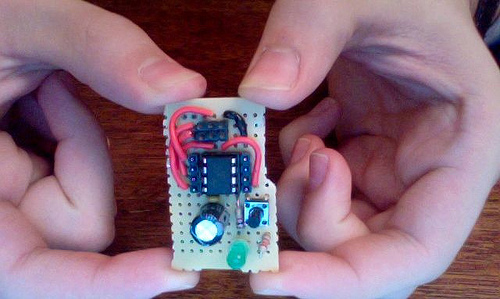ATTiny85 Development Board (Rev. A)
25th November 2011

I recently decided to do some development for the ATTiny85s I have laying around. I added a few of these to a Sparkfun order about a year ago to use up my Free Day money, but since I forgot about them and moved on to other electronics pursuits. However, I finally decided to start programming them and at the same time I decided to improve my prototyping skills, develop a really nice development board for them, and learn KiCAD.
KiCAD: First Impressions
12th November 2011
This weekend I decided to get some work in on learning KiCAD. I have not come very far, but I am starting to get oriented with eeschema and I have actually been enjoying it. However, I had to boot up into Ubuntu to work with it appropriately, because my Mac OS X install doesn’t quite like KiCAD, but then again I have trouble with Xilinx, iverilog, gtkwave, msp430-gcc, etc as well.
KiCAD works very smoothly for the most part with a couple of interfacing hitches. Namely you need to ctrl-drag to move multiple components, which took me far too long to figure out. Furthermore, I am not a fan of the built in library symbols for power, ground or the connectors. However, I don’t mind this so much because I am not completely opposed to making my own libraries, which will be uploaded to github, when I get a chance and open to all.
I really enjoy the way KiCAD works and the fact that it is open source, unlike EAGLE, and has no restrictions on it. Between work and past hobbyist work I have been exposed to Orcad Capture, EAGLE and EasyPCB/EasySCH. Orcad, though complicated, was my favorite of those schematic layout tools. The reason is that it has powerful hierarchies (I was doing large layouts) and very nice component making utilities, also there is a separation between the schematic phase and the PCB phase, which allows you to think about the actual functionality of the circuit during layout and the topology during PCB design. KiCAD follows a similar rule for schematic to PCB layout from what I can tell (more to come on this).
I would recommend KiCAD to anyone looking to do some schematic layout for free, with no restrictions.
Happy Hacking!
Lessons Learned: Breadboards are Noisy and So Are Those 7400s
15th October 2011
While building my 7400 drum machine for Dangerous Prototypes’ 7400 Competition I made a couple of good discoveries:
Those pre cut jumper wires which are very popular (the wiggly ones) are a blessing and a curse. For one they make things look messy, but they are easy to prototype with. However, their biggest negative is sometimes, combined with a breadboard, they can give noisy connections. However, these wires are awesome for prototyping! Example
Breadboards are noisy… I already knew this, but this project has confirmed it. While I very rarely actually get issues from the noise, it can be very frustrating when I am prototyping various parts of the circuitry which are noise sensitive. Furthermore, 7400 ICs really need two things badly: a good ground connection and a stable Vcc connection. There is however an easy way to get around this problem, or at least reduce it and that is the infamous 0.1uF ceramic capacitor to ground. Make sure you put these on all of your VCC inputs and you will reduce error propagation in your digital logic circuits… and its good practice.
Now I go back to work!
Happy Hacking!